



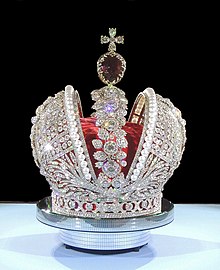


A crown is a traditional form of head adornment, or hat, worn by monarchs as a symbol of their power and dignity. A crown is often, by extension, a symbol of the monarch's government or items endorsed by it. The word itself is used, particularly in Commonwealth countries, as an abstract name for the monarchy itself (and, by extension, the state of which said monarch is head) as distinct from the individual who inhabits it (that is, The Crown). A specific type of crown (or coronet for lower ranks of peerage) is employed in heraldry under strict rules. Indeed, some monarchies never had a physical crown, just a heraldic representation, as in the constitutional kingdom of Belgium.
Variations
- Costume headgear imitating a monarch's crown is also called a crown hat. Such costume crowns may be worn by actors portraying a monarch, people at costume parties, or ritual "monarchs" such as the king of a Carnival krewe, or the person who found the trinket in a king cake.
- The nuptial crown, sometimes called a coronal, worn by a bride, and sometimes the bridegroom, at her wedding is found in many European cultures since ancient times. In the present day, it is most common in Eastern Orthodox cultures. The Eastern Orthodox marriage service has a section called the crowning, wherein the bride and groom are crowned as "king" and "queen" of their future household. In Greek weddings, the crowns are diadems usually made of white flowers, synthetic or real, often adorned with silver or mother of pearl. They are placed on the heads of the newlyweds and are held together by a ribbon of white silk. They are then kept by the couple as a reminder of their special day. In Slavic weddings, the crowns are usually made of ornate metal, designed to resemble an imperial crown, and are held above the newlyweds' heads by their best men. A parish usually owns one set to use for all the couples that are married there since these are much more expensive than Greek-style crowns. This was common in Catholic countries in the past.
- Crowns are also often used as symbols of religious status or veneration, by divinities (or their representation such as a statue) or by their representatives (e.g., the Black Crown of the Karmapa Lama) sometimes used a model for wider use by devotees.
- According to the New Testament, a crown of thorns was placed on the head of Jesus before his crucifixion; it has become a common symbol of martyrdom.
- According to Roman Catholic tradition, the Blessed Virgin Mary was crowned as Queen of Heaven after her assumption into heaven. She is often depicted wearing a crown, and statues of her in churches and shrines are ceremonially crowned during May.
- The Crown of Immortality is also common in historical symbolism.
- The heraldic symbol of Three Crowns, referring to the three evangelical Magi (wise men), traditionally called kings, is believed thus to have become the symbol of the Swedish kingdom, but it also fits the historical (personal, dynastic) Kalmar Union (1397–1520) between the three kingdoms of Denmark, Sweden, and Norway.
- In India, crowns are known as makuta (Sanskrit for "crest"), and have been used in India since ancient times and are described adorning Hindu gods or kings. The makuta style was then copied by the Indianized kingdoms that was influenced by Hindu-Buddhist concept of kingship in Southeast Asia, such as in Java and Bali in Indonesia, Cambodia, Burma and Thailand.
- In East Asia, there were crowns such as the Chinese mianguan and Japanese benkan worn by emperors.
- Dancers of certain traditional Thai dances often wear crowns (mongkut) on their head. These are inspired in the crowns worn by deities and by kings.
- In pre-Colonial Philippines crown-like diadems, or putong, were worn by elite individuals and deities, among an array of golden ornaments.
- The shamsa was a massive, jewel-inlaid ceremonial crown hung by a chain that was part of the regalia of the Abbasid and Fatimid Caliphates.
Terminology
Three distinct categories of crowns exist in those monarchies that use crowns or state regalia.
- Coronation
- Worn by monarchs when being crowned.
- State
- Worn by monarchs on other state occasions.
- Consort crowns
- Worn by a consort, signifying rank granted as a constitutional courtesy protocol.
Crowns or similar headgear, as worn by nobility and other high-ranking people below the ruler, are in English often called coronets; however, in many languages, this distinction is not made and the same word is used for both types of headgear (e.g., French couronne, German Krone, Dutch kroon). In some of these languages the term "rank crown" (rangkroon, etc.) refers to the way these crowns may be ranked according to hierarchical status. In classical antiquity, the crown (corona) that was sometimes awarded to people other than rulers, such as triumphal military generals or athletes, was actually a wreath or chaplet, or ribbon-like diadem.
History

Crowns have been discovered in pre-historic times from Haryana, India. The precursor to the crown was the browband called the diadem, which had been worn by the Achaemenid Persian emperors. It was adopted by Constantine I and was worn by all subsequent rulers of the later Roman Empire. Almost all Sassanid kings wore crowns. One of the most famous kings who left numerous statues, reliefs, and coins of crowns is the king Shapur I.
Numerous crowns of various forms were used in antiquity, such as the Hedjet, Deshret, Pschent (double crown) and Khepresh of Pharaonic Egypt. The Pharaohs of Egypt also wore the diadem, which was associated with solar cults, an association which was not completely lost, as it was later revived under the Roman Emperor Augustus. By the time of the Pharaoh Amenophis III (r.1390–1352c) wearing a diadem clearly became a symbol of royalty. The wreaths and crowns of classical antiquity were sometimes made from natural materials such as laurel, myrtle, olive, or wild celery.
The corona radiata, the "radiant crown" known best on the Statue of Liberty, and perhaps worn by the Helios that was the Colossus of Rhodes, was worn by Roman emperors as part of the cult of Sol Invictus prior to the Roman Empire's conversion to Christianity. It was referred to as "the chaplet studded with sunbeams" by Lucian, about 180 AD.

In the Christian tradition of European cultures, where ecclesiastical sanction authenticates monarchic power when a new monarch ascends the throne, the crown is placed on the new monarch's head by a religious official in a coronation ceremony. Some, though not all, early Holy Roman Emperors travelled to Rome at some point in their careers to be crowned by the pope. Napoleon, according to legend, surprised Pius VII when he reached out and crowned himself, although in reality this order of ceremony had been pre-arranged.
Today, only the British Monarchy and Tongan Monarchy, with their anointed and crowned monarchs, continue this tradition, although many monarchies retain a crown as a national symbol. The French Crown Jewels were sold in 1885 on the orders of the Third French Republic, with only a token number, their precious stones replaced by glass, retained for historic reasons and displayed in the Louvre. The Spanish Crown Jewels were destroyed in a major fire in the 18th century while the so-called "Irish Crown Jewels" (actually merely the British Sovereign's insignia of the Most Illustrious Order of St Patrick) were stolen from Dublin Castle in 1907, just before the investiture of Bernard Edward Barnaby FitzPatrick, 2nd Baron Castletown.
The Crown of King George XII of Georgia made of gold and decorated with 145 diamonds, 58 rubies, 24 emeralds, and 16 amethysts. It took the form of a circlet surmounted by ornaments and eight arches. A globe surmounted by a cross rested on the top of the crown.
Special headgear to designate rulers dates back to pre-history, and is found in many separate civilizations around the globe. Commonly, rare and precious materials are incorporated into the crown, but that is only essential for the notion of crown jewels. Gold and precious jewels are common in western and oriental crowns. In the Native American civilizations of the Pre-Columbian New World, rare feathers, such as that of the quetzal, often decorated crowns; so too in Polynesia (e.g., Hawaii).
Coronation ceremonies are often combined with other rituals, such as enthronement (the throne is as much a symbol of monarchy as the crown) and anointing (again, a religious sanction, the only defining act in the Biblical tradition of Israel).
In other cultures, no crown is used in the equivalent of coronation, but the head may still be otherwise symbolically adorned; for example, with a royal tikka in the Hindu tradition of India.
Gallery
-
 Crown of Darius the Great, c. 500 BC.
Crown of Darius the Great, c. 500 BC.
-
 The ancient Greek Kritonios Crown, funerary or marriage material, 370–360 BCE, from a grave in Armento, Basilicata (State Collections of Antiquities, Munich).
The ancient Greek Kritonios Crown, funerary or marriage material, 370–360 BCE, from a grave in Armento, Basilicata (State Collections of Antiquities, Munich).
-
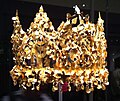 Tillya Tepe Crown (Afghanistan, 1st century AD)
Tillya Tepe Crown (Afghanistan, 1st century AD)
-
 The Essen Crown, the world's oldest lily crown (10th or 11th century), cathedral treasury, Essen Minster, Essen
The Essen Crown, the world's oldest lily crown (10th or 11th century), cathedral treasury, Essen Minster, Essen
-
 The Papal tiara, worn by the popes to symbolize their authority within the Catholic Church, was last used in 1963 (St. Peter's Basilica, Vatican City).
The Papal tiara, worn by the popes to symbolize their authority within the Catholic Church, was last used in 1963 (St. Peter's Basilica, Vatican City).
-
 Imperial Crown of the Holy Roman Empire, c. 962, Imperial Treasury, Vienna
Imperial Crown of the Holy Roman Empire, c. 962, Imperial Treasury, Vienna
-
 St Edward's Crown (1661)
St Edward's Crown (1661)
-
 Archducal hat of Austria, c. 1616, Klosterneuburg Monastery
Archducal hat of Austria, c. 1616, Klosterneuburg Monastery
-
 Crown of Saint Wenceslas, 1346 (Lands of the Bohemian Crown), St. Vitus Cathedral, Prague
Crown of Saint Wenceslas, 1346 (Lands of the Bohemian Crown), St. Vitus Cathedral, Prague
-
 Crown of the Crowned Virgin of the Kings (Corona de la Virgen de los Reyes Coronada), 1904, Seville Cathedral
Crown of the Crowned Virgin of the Kings (Corona de la Virgen de los Reyes Coronada), 1904, Seville Cathedral
-
 Crown of the Andes, ca. 1660-1770, made for a larger than life-size statue of the Virgin Mary in the Cathedral of Popayán, Colombia. Now is at the Metropolitan Museum of Art
Crown of the Andes, ca. 1660-1770, made for a larger than life-size statue of the Virgin Mary in the Cathedral of Popayán, Colombia. Now is at the Metropolitan Museum of Art
-
 Crown of Isabella of Castile in the Royal Chapel of Granada
Crown of Isabella of Castile in the Royal Chapel of Granada
-
 Crown of the Virgin of the Tabernacle of Cathedral of Toledo, c. 15th century, Spain
Crown of the Virgin of the Tabernacle of Cathedral of Toledo, c. 15th century, Spain
-
 Imperial crown of Maximilian I of Mexico (1864-1867) as funerary insignia, located in the Imperial Furniture Collection in Vienna.
Imperial crown of Maximilian I of Mexico (1864-1867) as funerary insignia, located in the Imperial Furniture Collection in Vienna.
-
 Imperial Crown of Pedro II of Brazil (1841)
Imperial Crown of Pedro II of Brazil (1841)
-
 Crown of the Netherlands
Crown of the Netherlands
-
 Crown of the Kingdom of Bavaria (Paris 1806), Munich Residenz
Crown of the Kingdom of Bavaria (Paris 1806), Munich Residenz
-
 The Holy Crown of Hungary, also called the Crown of Saint Stephen, of the Kingdom of Hungary (Byzantine work, Constantinople (Istanbul), 11th century), Hungarian Parliament Building, Budapest
The Holy Crown of Hungary, also called the Crown of Saint Stephen, of the Kingdom of Hungary (Byzantine work, Constantinople (Istanbul), 11th century), Hungarian Parliament Building, Budapest
-
Grand Ducal Crown of Baden, 1811 (Karlsruhe Palace), made of a wire frame reinforced with paperboard, crimson coloured velvet, gold-plated sheet silver, yellow silk taffeta embroidered with gold threads, set with gold-plated sequins, diamonds and rubies.
-
 Crown of Württemberg, Württemberg State Museum, Stuttgart (1806)
Crown of Württemberg, Württemberg State Museum, Stuttgart (1806)
-
Crown of Stephen Bocskai (Turkish goldwork, c. 1605, Imperial Treasury, Vienna)
-
 Crown of Wilhelm II of the Kingdom of Prussia, Hohenzollern Castle
Crown of Wilhelm II of the Kingdom of Prussia, Hohenzollern Castle
-
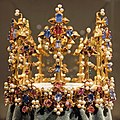 The Palatine Crown, also called the Bohemian Crown, of Princess Blanche of England, c. 1370–80, Munich Residenz
The Palatine Crown, also called the Bohemian Crown, of Princess Blanche of England, c. 1370–80, Munich Residenz
-
 Emperor's Crown on the Bust of Charlemagne (Mosan goldwork, c. 1350), Aachen Cathedral
Emperor's Crown on the Bust of Charlemagne (Mosan goldwork, c. 1350), Aachen Cathedral
-
Crown of Empress Cunigunde c. 1060–1070, Munich Residenz
-
Gothic lily crown of Empress Cunigunde, 14th century (Munich Residenz)
-
 Reliquary Crown of Henry II, Munich Residenz c. 1270–1300
Reliquary Crown of Henry II, Munich Residenz c. 1270–1300
-
 Crown of Augustus III of Poland c. 1733
Crown of Augustus III of Poland c. 1733
-
 Crown on the bust of John the Baptist, c. 1370, St. Johann-Baptist church, Aachen
Crown on the bust of John the Baptist, c. 1370, St. Johann-Baptist church, Aachen
-
 Crown of Queen Therese of Bavaria (c. 1830), Munich Residenz
Crown of Queen Therese of Bavaria (c. 1830), Munich Residenz
-
 Crown of Margaret of York c. 1461, Aachen Cathedral
Crown of Margaret of York c. 1461, Aachen Cathedral
-
 Kiani Crown (Iran-Qajar dynasty)
Kiani Crown (Iran-Qajar dynasty)
-
 Pahlavi Crown (Iran-Pahlavi dynasty)
Pahlavi Crown (Iran-Pahlavi dynasty)
-
Empress Crown (Iran-Pahlavi dynasty)
-
Replica of the destroyed Crown of Bolesław I the Brave of Poland.
-
 Medieval Crown of Bulgaria kept in the National history museum of Bulgaria
Medieval Crown of Bulgaria kept in the National history museum of Bulgaria
-
 Russian tsar's crown (14th century)
Russian tsar's crown (14th century)
-
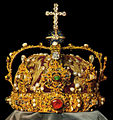 Royal Crown of Sweden (1561)
Royal Crown of Sweden (1561)
-
 Replica of the crown designed for the Finnish monarch, who never reigned. A contemporary crown was never crafted, but the replica was made from original drawings in the 1980s.
Replica of the crown designed for the Finnish monarch, who never reigned. A contemporary crown was never crafted, but the replica was made from original drawings in the 1980s.
-
 Reproduction of Imperial Crown of Napoleon III of France.
Reproduction of Imperial Crown of Napoleon III of France.
-
 The Imperial crown of Chinese emperor (Ming Dynasty) (1368–1644)
The Imperial crown of Chinese emperor (Ming Dynasty) (1368–1644)
-
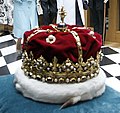 Crown of Scotland (1540) at the Parliament of Scotland, (Kept at Edinburgh Castle)
Crown of Scotland (1540) at the Parliament of Scotland, (Kept at Edinburgh Castle)
-
 Karađorđević Crown (Serbia)
Karađorđević Crown (Serbia)
-
 Makuta Binokasih, the crown of Sunda Kingdom, 14th century West Java, Indonesia
Makuta Binokasih, the crown of Sunda Kingdom, 14th century West Java, Indonesia
-
 The crown of Banten Sultanate, 16th century Banten, Indonesia
The crown of Banten Sultanate, 16th century Banten, Indonesia
-
 The crown of King Christian IV of Denmark (16th century), currently located in Rosenborg Castle, Copenhagen.
The crown of King Christian IV of Denmark (16th century), currently located in Rosenborg Castle, Copenhagen.
-
 Crown of Louis XV
Crown of Louis XV
-
 Crown of King George XII of Georgia
Crown of King George XII of Georgia
-
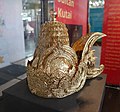 The crown of Kutai Kartanegara Sultanate, 19th century East Kalimantan, Indonesia
The crown of Kutai Kartanegara Sultanate, 19th century East Kalimantan, Indonesia
-
 The Great Crown of Victory (Thailand)
The Great Crown of Victory (Thailand)
-
 Imperial Crowns of Head of the States of Kingdom of Nepal (19th century). Preserved
Imperial Crowns of Head of the States of Kingdom of Nepal (19th century). Preserved
-
 Kingdom of Iran Pahlavi Golden Crown
Kingdom of Iran Pahlavi Golden Crown
-
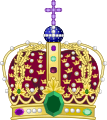 Crown of the King of Norway
Crown of the King of Norway
-
 Heraldic crown of the Russian Empire.
Heraldic crown of the Russian Empire.
-
 Heraldic version of the crown of Tonga.
Heraldic version of the crown of Tonga.
-
The Palatine tiara of Pope Pius IX (19th Century)
-
 The Imperial crown of Japanese emperor Kōmei (1831–1867).
The Imperial crown of Japanese emperor Kōmei (1831–1867).
-
 Crown of Flowers, by William-Adolphe Bouguereau, 1884.
Crown of Flowers, by William-Adolphe Bouguereau, 1884.
-
 Ströhl's Heraldischer Atlas, 1899
Ströhl's Heraldischer Atlas, 1899
-
 The Imperial Crown of India, worn by Emperor George V at his Delhi Durbar (1911).
The Imperial Crown of India, worn by Emperor George V at his Delhi Durbar (1911).
-
Tiara of Pope Benedict XVI (21st Century)
-
 Yoruba Oba's crown of Onijagbo Obasoro Alowolodu; late 19th century
Yoruba Oba's crown of Onijagbo Obasoro Alowolodu; late 19th century
-
 Gold crown from Seobongchong Tumulus, Silla dynasty; 5th-6th century
Gold crown from Seobongchong Tumulus, Silla dynasty; 5th-6th century
-
 Crown of Carol I forged from an Ottoman cannon captured by the Romanian Army during the 1877-1878 War.
Crown of Carol I forged from an Ottoman cannon captured by the Romanian Army during the 1877-1878 War.
Numismatics
Because one or more crowns, alone or as part of a more elaborate design, often appear on coins, several monetary denominations came to be known as 'a crown' or the equivalent word in the local language, such as krone. This persists in the case of the national currencies of the Scandinavian countries and the Czech Republic. The generic term "crown sized" is frequently used for any coin roughly the size of an American silver dollar (ie., approximately 26.5mm diameter).
See also
- Benkan
- Circlet
- Coronet
- Crown jewels
- Diadem
- Fengguan
- Helmet
- Holy Crown of Hungary (Crown of St. Stephen)
- Hoop crown
- Heraldic crowns
- Imperial Crown
- Korymbos (headgear)
- Laurel wreath
- Makuṭa
- Mianguan
- Mitre
- Goffa
- Nemes
- Oba's crown
- Papal tiara
- Polos
- Presidential sash
- Pschent
- Tiara
- Chada and mongkut
- List of Royal Crowns
- Ukpe-okhue
- War bonnet
- Hat
- Tefillin
References
- Itsios, Alex. "Gold of Ancestors - Ayala Museum". www.ayalamuseum.org. Archived from the original on 2017-06-25. Retrieved 2017-07-01.
- "12 Surprising Facts You Didn't Know About Ancient Philippines". 4 July 2018. Archived from the original on 9 July 2017. Retrieved 1 July 2017.
- Halm, H. (1997). "SHAMSA". In Bosworth, C.E.; van Donzel, E.; Heinrichs, W.P.; Lecomte, G. (eds.). The Encyclopaedia of Islam, Vol. IX (SAN-SZE) (PDF). Leiden: Brill. pp. 298–9. ISBN 90-04-10422-4. Archived (PDF) from the original on 2022-03-25. Retrieved 13 June 2022.
- "Stone Pages Archaeo News: 4,000-year-old copper crown unearthed in India". Archived from the original on 2021-09-28. Retrieved 2020-12-16.
- Al-Azmeh, Aziz (2001). Muslim Kingship: Power and the Sacred in Muslim, Christian and Pagan Politics. London: I.B. Tauris Publications. p. 12. ISBN 1-86064-609-3.
- "Winners of Panhellenic Games Received Victory Wreaths". ThoughtCo. Archived from the original on 2023-03-10. Retrieved 2023-03-10.
- in Alexander the false prophet Archived 2016-11-26 at the Wayback Machine)
- "Crown of the Virgin of the Immaculate Conception, known as the Crown of the Andes". Metropolitan Museum of Art website. Archived from the original on 2023-05-18. Retrieved 2023-06-04.
- "Gemstone Gallery". 2018-05-29. Archived from the original on 2018-05-29. Retrieved 2022-10-04.
External links
- Fallow, Thomas Macall (1911). "Crown and Coronet" . In Chisholm, Hugh (ed.). Encyclopædia Britannica. Vol. 7 (11th ed.). Cambridge University Press. pp. 515–518.
| Types of crown | ||
|---|---|---|
| By rank |  | |
| By use | ||
| By form | ||
| Parts | ||
| Other | Wreath | |
| Jewellery | |||||||||||||
|---|---|---|---|---|---|---|---|---|---|---|---|---|---|
| Forms | |||||||||||||
| Making |
| ||||||||||||
| Materials |
| ||||||||||||
| Terms |
| ||||||||||||
| |||||||||||||
| Coronation and enthronement | |
|---|---|
| Regalia | |
| |
| By continent | |
| Specific customs | |
| See also | |
| Headwear | |||||||||
|---|---|---|---|---|---|---|---|---|---|
| |||||||||
| Helmets |
| ||||||||
| Other protective | |||||||||
| Hairwear and other items | |||||||||
| Eyewear | |||||||||
| List of headwear | |||||||||
